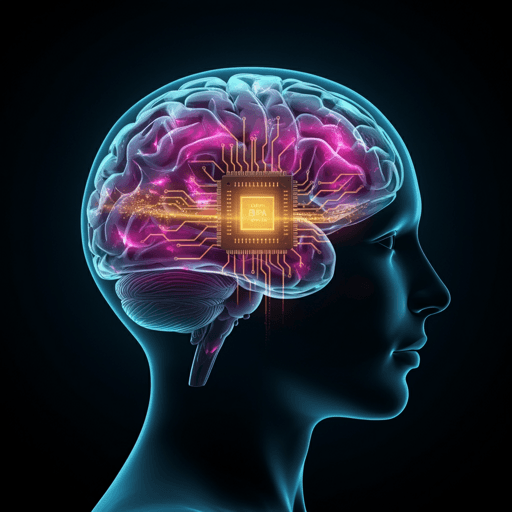
Engineering and Technology
Real-time, neural signal processing for high-density brain-implantable devices
A. M. Sodagar, Y. Khazaei, et al.
High-density intracortical implants promise thousands of channels, but massive recorded data threatens to bottleneck wireless brain microsystems. This review examines the technical challenges of streaming data off implants and surveys on-implant, hardware-efficient digital signal processing methods — including spike detection and extraction, temporal and spatial compression, and spike sorting — to enable low-power, real-time operation. This research was conducted by Amir M. Sodagar, Yousef Khazaei, Mahdi Nekoui, and MohammadAli Shaeri.
~3 min • Beginner • English
Introduction
This review addresses the central challenge created by the rapid growth in recording density of intracortical microelectrode arrays: real-time handling and wireless transmission of massive neural data streams under strict implant constraints. The paper motivates on-implant, hardware-efficient signal processing as the most effective path to reduce data volume while preserving information content necessary for neuroscience, BCIs, and therapeutic applications. Context is provided on brain-implantable microsystems and signal characteristics (action potentials, LFPs, noise), typical front-end bandwidths (100–300 Hz high-pass with 6–10 kHz bandwidth), sampling rates (up to 20–30 kS/s) and quantization (8–10 bits). The purpose is to survey and organize techniques for spike detection/extraction, temporal and spatial compression, and spike sorting that meet implant requirements in accuracy, low complexity, low power, small area, and real-time operation.
Literature Review
The paper synthesizes two decades of work on on-implant neural signal processing for high-density recording devices. It reviews spike detection methods based on hard thresholding in time domain amplitude, absolute value, nonlinear energy operator (NEO), Haar wavelet coefficients, and smoothness measures; thresholds may be user-defined or adaptive (typically 3–7× noise standard deviation), implemented in analog or digital domains, with recent current-mode enhancement filters. Spike extraction approaches range from partial waveshape extraction beyond symmetric thresholds to fixed-length and adaptive-length window extraction to preserve spike integrity. The review categorizes data compression into temporal and spatial methods. Temporal compression includes delta coding for lossless reduction of entire signals, transform-domain spike compression using DWT (symlet4), DHWT (Haar), WHT, DCT, truncated approximate Tchebycheff (Tchebycheff/CATCH), and polynomial piecewise curve fitting with salient sample telemetry and regression-based reconstruction. Spatial compression exploits redundancies across adjacent channels, including whitening transforms with hardware-efficient implementations, MBED extraction of common baselines (LFP) and separate telemetry of baseline plus per-channel differences for lossless compression, and spatio-temporal band separation for separate handling of LFP and spikes. A comparative summary (Table 1) reports compression rates, technology nodes, per-channel area and power across works. Spike sorting literature spans supervised and unsupervised online clustering tailored for hardware efficiency: L1-norm distance sorting, Geo-OSort, hierarchical adaptive means (HAM), oblique decision trees, salient feature selection with window discrimination, correlation-coefficient-based sorting, autoencoder-based feature extraction with similarity-based K-means, and template-matching architectures optimized for on-chip operation. The paper distinguishes hardware-implemented versus hardware-embedded compression, highlighting compressive amplifiers (log), compressive ADCs with anti-log transfer (signal-specific resolution focused on spikes), MBED implemented within multi-channel ADCs, wired-OR ADC arrays, and event-driven/adaptive sampling/resolution ADCs. It further reviews telemetry-level compaction via framing and Intertwined Pulse Modulation (IPM). Quantitative metrics for recognition (accuracy, precision, sensitivity, specificity, F1, ROC, ARI, NMI), compression (CR, TCR), reconstruction error (RMS, MAE), and hardware (normalized power/area per channel, MACs/gates) are described to enable fair comparisons. Challenges and future directions emphasize hardware/processing co-design, smart signal processing (AI), protected operation, and personalized adaptive processing.
Methodology
This is a narrative review organizing on-implant neural signal processing techniques by function and implementation. The authors synthesize prior works into three primary categories (spike detection/extraction, data compression—temporal and spatial, and spike sorting), and further distinguish hardware-implemented versus hardware-embedded realizations along the signal path (front-end, ADC, and wireless back-end). Comparative specifications from representative publications are summarized (e.g., compression rate, technology node, supply voltage, area/power per channel) and standard signal-processing and hardware metrics are outlined to support cross-study evaluation. No experimental dataset was generated; training phases for spike sorting are recommended off-implant, with sorting performed online on-implant.
Key Findings
- On-implant signal processing is essential to overcome the recording density–transmission bandwidth and power constraints in future high-channel-count implants.
- Spike detection can be achieved with low-complexity methods (thresholding on amplitude/absolute value, NEO, Haar domain coefficients, smoothness) and adaptive thresholds (typically 3–7× noise σ), implemented in analog or digital forms; recent current-mode enhancement filters improve SNR.
- Spike extraction using fixed or adaptive windows preserves waveshape integrity and enables downstream compression and sorting.
- Temporal compression: transform-based spike compression avoids multipliers with Haar/WHT/DCT; approximate/truncated Tchebycheff (CATCH) concentrates energy in few coefficients enabling aggressive truncation. Salient sample extraction with piecewise polynomial fitting yields strong compaction and denoising.
- Spatial compression: whitening and MBED remove common LFP and correlated components across channels for lossless compression and reduced ADC burden; combined temporal×spatial methods multiply gains.
- Representative compression and implementation metrics (Table 1):
• DWT (Symlet4): CR ≈ 64; 500 nm CMOS; ~0.18 mm²/ch; ~94 µW/ch.
• Haar (DHWT): CR ≈ 116.4; TCR ≈ 903; 130 nm; ~0.0032 mm²/ch; ~1.47 µW/ch.
• WHT: CR ≈ 63; TCR ≈ 504; 180 nm; ~0.0128 mm²/ch; ~0.63 µW/ch.
• DCT: CR ≈ 69; TCR ≈ 552; 65 nm; ~0.018 mm²/ch; ~0.74 µW/ch.
• Whitening transform (spatial): CR ≈ 122; 180 nm; ~0.0093 mm²/ch; ~7.43 µW/ch.
• Tchebycheff transform (temporal): CR ≈ 154; TCR ≈ 1232; 180 nm; ~0.011 mm²/ch.
• Salient sample extraction: CR ≈ 272; TCR ≈ 2174; 130 nm; ~0.0028 mm²/ch; ~0.164 µW/ch.
• Event-based spatial grouping (ADC-level): CR ≈ 20; 65 nm; ~0.00007 mm²/ch; ~0.02 µW/ch.
- Hardware-embedded compression in front-ends and ADCs (log amplifiers; anti-log ADCs) preferentially allocate resolution to sparse spikes while coarse-quantizing background noise, improving data and power efficiency.
- Telemetry compaction via protocol design and Intertwined Pulse Modulation (IPM) increases symbol-rate efficiency by overlapping symbols, leveraging temporal properties of neural signals.
- Complexity-reduction strategies (variance-based detection avoiding sqrt, multiplier-free transforms, removing common denominators in correlation-based sorting, approximate correlation via shifts/adds, truncation of LSBs/MSBs, fixed-point arithmetic, bitfields) materially reduce area and power with negligible impact on signal fidelity.
- Metrics for fair evaluation include CR/TCR, reconstruction error (RMS/MAE), and normalized hardware power/area per channel across technology nodes; typical recording parameters: 100–300 Hz high-pass, 6–10 kHz bandwidth, 20–30 kS/s sampling, 8–10 bit quantization.
Discussion
The review demonstrates that shifting substantial processing onto the implant—while rigorously optimizing for hardware efficiency—directly addresses the bottlenecks in real-time data handling and limited wireless bandwidth for high-density systems. By prioritizing sparse-event-centric methods (spike detection/extraction, transform-domain compaction, salient sample telemetry) and exploiting spatial redundancies, the techniques preserve critical information (spike timing and class) while achieving orders-of-magnitude reductions in transmitted bits and on-chip power/area. The separation of hardware-implemented and hardware-embedded strategies provides a design palette to distribute compression across the signal path (front-end, ADC, telemetry), easing constraints on each subsystem. The discussion of metrics and normalization underscores the need for standardized reporting to compare designs fairly. Collectively, the surveyed algorithms and circuits make real-time streaming of thousands of channels plausible by transmitting higher-level representations (e.g., spike labels) rather than raw samples, enabling practical prosthetic, therapeutic, and research applications.
Conclusion
Hardware-efficient, on-implant neural signal processing—centered on spike detection/extraction, temporal and spatial compression, and online spike sorting—is pivotal for next-generation high-density brain implants. Success hinges on co-design of algorithms and circuits to meet strict constraints in power, area, and real-time operation, with compression and data reduction embedded throughout the signal path. Future work should emphasize hardware/processing co-optimization, AI-enabled smart processing, robust privacy and security for wireless operation, and personalized adaptive methods that tailor processing to subject- and session-specific signal characteristics.
Limitations
As a narrative review, the paper does not present a systematic search protocol or quantitative meta-analysis. Comparative results are drawn from heterogeneous studies with differing datasets, recording conditions, and technology nodes; while normalization metrics are discussed, direct head-to-head benchmarking under identical conditions is limited. No new experimental data or unified implementation is provided, and real-world trade-offs (e.g., long-term stability, biocompatibility impacts of heat) are discussed conceptually rather than empirically.
Related Publications
Explore these studies to deepen your understanding of the subject.







